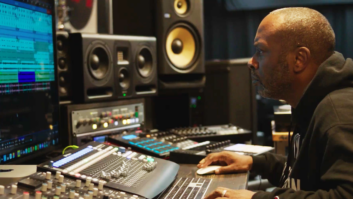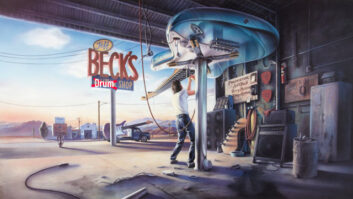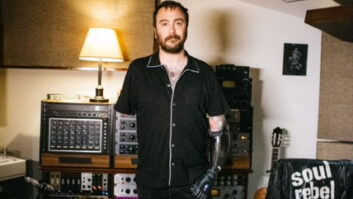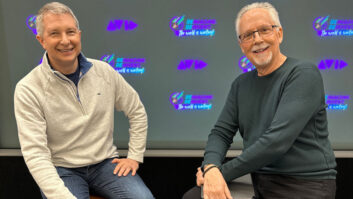A STUDIO PRO FINDS HIS HOMEGrowing up in Old Greenwich, Conn., the son of a professional trumpet player who headed off to New York City to play ballets at the Met, shows on Broadway and tons of session dates, keyboardist/composer/arranger Jeff Bova was raised in an atmosphere steeped in love for all styles of music.
“I can remember going to Broadway shows to watch my dad play,” he says from his basement studio at Avatar Studios (formerly Power Station), New York City. “It was so fantastic – someone I knew was involved with this amazing experience!” Bova took up the trumpet in elementary school and continued with it through Berklee College of Music and the Manhattan School of Music. But, it was keyboards that would prove to be his lifelong axe after he picked up a Hammond M-3 at the age of 15.
When Bova left college in the mid-’70s, jazz fusion was peaking and he joined a violinist friend in a band called Flying Island. “I was knocking around in Connecticut with various bands, but no deals came,” he says. “I started taking private arranging and composition lessons with a guy named Dr. Maury Deutsch. He was like a guru to me, opening up my mind to music and creativity in ways I never imagined. I really recommend that younger people trying to get into the business find a mentor like him.”
In addition to the music lessons he was receiving, coming into town to study plugged Bova back into the New York scene. One day, he was asked to join the group Change, which featured a little-known singer named Luther Vandross. “Luther was brilliant,” Bova recalls. “I was very new to dance music and R&B, and this band, and Luther in particular, really opened my ears to these styles.” After several years with the group, Bova was a full-fledged New Yorker, ready for his big break.
It came when he met Bill Laswell. “It must have been back in ’83 when I was working with Nona Hendryx that I met Bill,” Bova says. “He was getting ready to produce Herbie Hancock’s Rockit album. Herbie played a lot of Rhodes Chroma on that album, and when he and Bill put together a band to go on the road to support it, I was chosen. My knowledge of that instrument played a big role in his decision.”
Bova worked with Hancock over a three-year period. “Every gig was a great lesson for me. Just watching how he perceives and plays music, it’s hard to describe how brilliant he is. His clavinet playing is amazing. Herbie and Stevie Wonder are in that same space, as far as I’m concerned, of being among the best clavinet players of all time. It’s all about the feel with both of them. Plus, Herbie has this tremendous harmonic sense.”
His professional association with Hancock continued through Sound-System, the follow-up album to Rockit. Along the way, Bova was programming and composing some cues for several of Hancock’s film projects, including the Sean Penn vehicle Colors. And people were beginning to take notice of him. At that point, Bova decided he needed a studio.
“My first session at the Power Station was in the early ’80s, over in Studio B. Scott Litt was a house producer/engineer at the time,” Bova says. “He saw me packing up my rig and told me I couldn’t leave because a session of his was starting and they needed some synth on the track. It turned out to be a Robert Gordon record! That was the start of my relationship with the studio.
“Things were really busy there for a while. I can remember working on True Colors with Cyndi Lauper in the morning over in Studio A, then moving over to Studio C to work with Billy Joel on The Bridge. To top things off, David Lee Roth had me working on Eat ‘Em & Smile over in Studio B. I was working on all three of these records at the same time. The Bongiovis and Bob Walters [of Power Station] were taken with the idea of having a house guy. Then one of them – I don’t remember who – jokingly said that they might as well give me a room since I practically lived there already.”
By the late ’80s, Bova had his own room in the studio’s basement. Advantages accrued to both sides, Bova says. “Barry Bongiovi said something once that struck me – what they do for clients is their job, but that they enjoy being part of the aesthetic experience and watching a song or production develop is particularly satisfying to them. That’s what I do in my room.
“I also get many benefits out of being based here in Avatar. From the beginning, I was given access to the entire facility to make dubs when I need them, tape transfers, anything that requires the equipment the studio owns. The owners have also provided me with studio time whenever possible. Of course, lots of situations involve studio clients who have chosen to work with me in-house. While management has made it a policy never to sell my services, there’s also been a philosophy that says doing pre-production done in-house keeps things in-house.”
Clients who come to Bova based on his track record get some additional benefits from working at Avatar, even if they end up tracking elsewhere. “There’s a convenience factor that comes with working in a full-service facility,” he notes. “We have lots of phones, clients can order food, all the amenities they would expect from a major studio they have when they’re working in my project space. It’s a whole different vibe than I’d have if I was working in an office building over on 28th Street.”
Bova’s studio setup, built by Vince Gutman, centers around racks that are multipinned to a central patchbay. (However, tie lines between his room and Avatar’s main studios do not exist.) Initially, he moved the whole rig room to room and then tape machines were brought into his room for dumps. Unwieldy multitracks gave way to Bova’s Sony PCM-800 decks (Sony’s version of the Tascam DA-88). These days, the ubiquitous Pro Tools is his platform of choice. “Hot, swapping drives has made things totally transparent,” Bova says. “Clients come here with material they’ve begun on Pro Tools and dropped to a hard drive or CD-ROM. I boot the session on my rig and continue to work. When we’re done here, we drop to hard drive once again and send the drive off to wherever it’s going next – upstairs or to some other country.”
A Speck Xtramix CX 40-input console handles the synth routing in Bova’s facility. “It’s been a great piece for my setup. I pass the stereo bus analog out to an old Neumann mastering EQ. I wish I could tell you the model, but there’s none on it! I also use a Drawmer 1960 tube compressor on the stereo bus. This combination is very effective, both for solo tracks and groupings.”
While he doesn’t consider himself an engineer, per se, Bova says that he feels comfortable “creating a keyboard environment on tape, or hard drive, whatever the recording medium is. I like to bring in another set of ears when I record vocals and guitars in my studio, but I’ve also tracked live stuff that has made it to final mixes, partly because of the mics I use. My two favorites are the Brauner VM1 and a Sony G-800G. The Brauner has a lot of detail, but it doesn’t lose the warmth and depth of a vocalist. The G-800G is known to some as the Mariah/Celine vocal mic. It also has bright characteristics, but it feels very true to the source.”
Speaking of Celine Dion, Bova won a Grammy for his work on her Falling Into You CD. “I’ve worked with Jim Steinman for almost 15 years,” he explains. “He produced three tracks on that album, one of which I co-produced with him. That song,`Call the Man,’ had vocals tracked at the Hit Factory. I did the entire backing track here in my room. We used a Sony 3348 to transfer parts on that project, as well. Steve Rinkoff, who’s been Jim’s engineer for years, helped with the dump.”
As Bova looks to the future, he sees himself eventually moving away from his huge collection of electronic keyboards: “I’m one of those guys who likes to get his hands on knobs to tweak things, but soft synths are really intriguing me – like the BitHeadz stuff. I really see their software being part of my future. The main reason why I see myself making the switch one day is that you can organize all of your sampled sounds so effectively with these tools. Forty-gig drives are inexpensive now; you can have all of your sounds at the touch of a fingertip. No more digging around for CD-ROMs or tape drives you’ve off-loaded banks to. Then there’s the sheer convenience of having all of your synths living as software on one dedicated computer. It’s definitely the wave of the future.”




